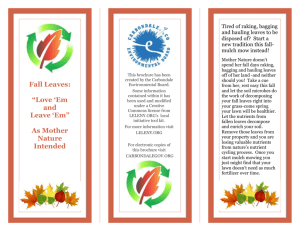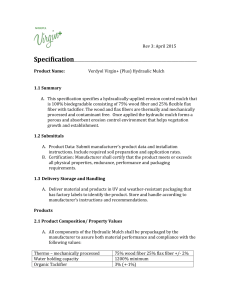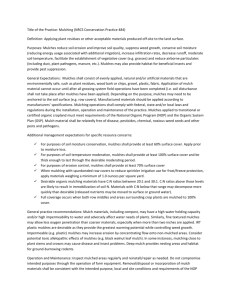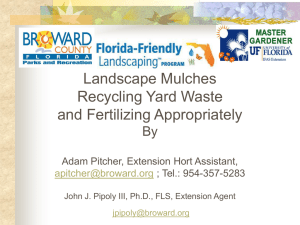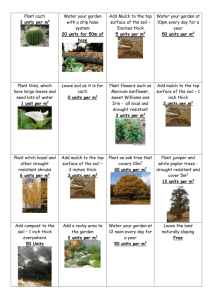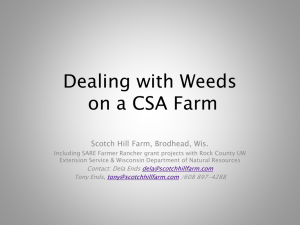Mulching Helps the Environment
advertisement
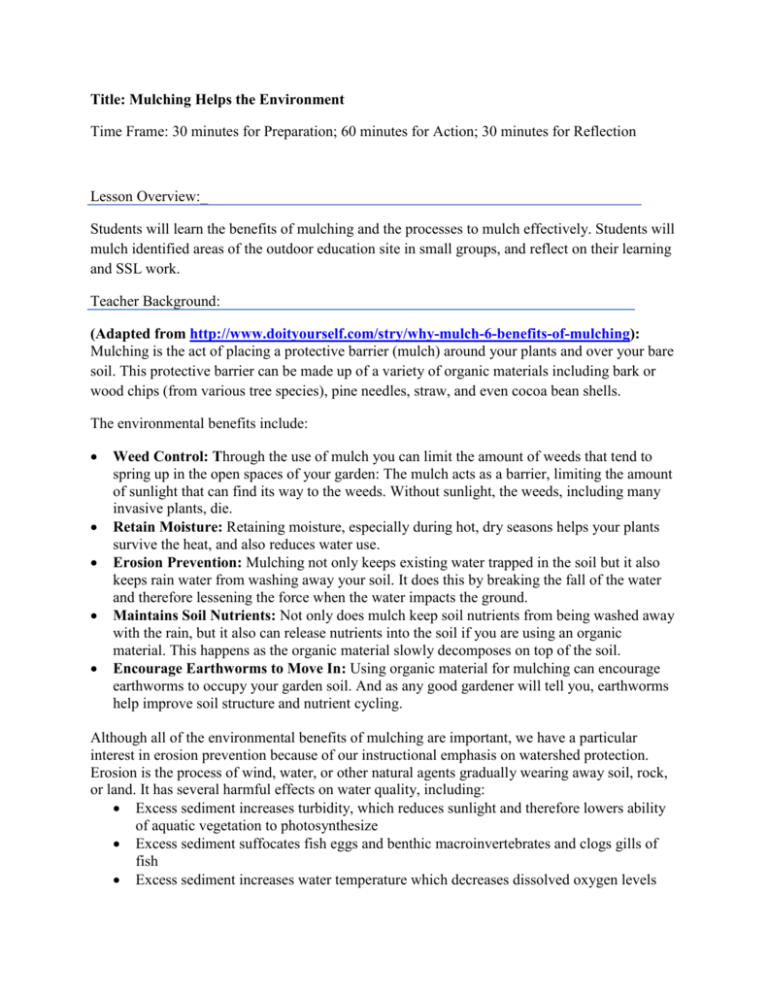
Title: Mulching Helps the Environment Time Frame: 30 minutes for Preparation; 60 minutes for Action; 30 minutes for Reflection Lesson Overview:_ Students will learn the benefits of mulching and the processes to mulch effectively. Students will mulch identified areas of the outdoor education site in small groups, and reflect on their learning and SSL work. Teacher Background: (Adapted from http://www.doityourself.com/stry/why-mulch-6-benefits-of-mulching): Mulching is the act of placing a protective barrier (mulch) around your plants and over your bare soil. This protective barrier can be made up of a variety of organic materials including bark or wood chips (from various tree species), pine needles, straw, and even cocoa bean shells. The environmental benefits include: Weed Control: Through the use of mulch you can limit the amount of weeds that tend to spring up in the open spaces of your garden: The mulch acts as a barrier, limiting the amount of sunlight that can find its way to the weeds. Without sunlight, the weeds, including many invasive plants, die. Retain Moisture: Retaining moisture, especially during hot, dry seasons helps your plants survive the heat, and also reduces water use. Erosion Prevention: Mulching not only keeps existing water trapped in the soil but it also keeps rain water from washing away your soil. It does this by breaking the fall of the water and therefore lessening the force when the water impacts the ground. Maintains Soil Nutrients: Not only does mulch keep soil nutrients from being washed away with the rain, but it also can release nutrients into the soil if you are using an organic material. This happens as the organic material slowly decomposes on top of the soil. Encourage Earthworms to Move In: Using organic material for mulching can encourage earthworms to occupy your garden soil. And as any good gardener will tell you, earthworms help improve soil structure and nutrient cycling. Although all of the environmental benefits of mulching are important, we have a particular interest in erosion prevention because of our instructional emphasis on watershed protection. Erosion is the process of wind, water, or other natural agents gradually wearing away soil, rock, or land. It has several harmful effects on water quality, including: Excess sediment increases turbidity, which reduces sunlight and therefore lowers ability of aquatic vegetation to photosynthesize Excess sediment suffocates fish eggs and benthic macroinvertebrates and clogs gills of fish Excess sediment increases water temperature which decreases dissolved oxygen levels Pesticides, metals, toxins, oil, and grease can cling to sediment and erode into the waterway Phosphate can wash into the water and cause algal blooms, which cause severe decreases in dissolved oxygen Mulching is part of the solution! Mulching slows the movement of rainwater, thereby reducing the amount of soil that is eroded by rain. Thus, mulch decreases the amount of sediment in runoff in local waterways. In summary, mulching helps to support biodiversity by creating a healthier environment in which native plants and animals can survive to reproduce. Enduring Understanding & Essential Questions: Enduring Understandings: Natural resources need protection and conservation in a given environment. Biodiversity is a natural resource. Essential Question: How can people help maintain and increase biodiversity in their local environment? Next Generation Science Standards: Science and Engineering Practices Engaging in Argument from Evidence Evaluate competing design solutions based on jointly developed and agreed-upon design criteria. Disciplinary Core Ideas Crosscutting Concepts Interdependent Relationships in Ecosystems Stability and Change In any ecosystem, organisms and populations with similar requirements for food, water oxygen, or other resources may compete with each other for limited resources, access to which consequently constrains their growth and reproduction. Small changes in one part of a system might cause large changes in another part. Biodiversity describes the variety of species found in Earth’s terrestrial and oceanic ecosystems. The completeness or integrity of an ecosystem’s biodiversity is often used as a measure of its health. Performance Expectation MS-LS2-5 Evaluate competing design solutions for maintaining biodiversity and ecosystem services. (Clarification Statement: Example of ecosystem services could include water purification, nutrient recycling, and prevention of soil erosion. Examples of design solution constraints could include scientific, economic, and social considerations.) Maryland Environmental Literacy Standards STANDARD 1 ENVIRONMENTAL ISSUES The student will investigate and analyze environmental issues ranging from local to global perspectives and develop and implement a local action project that protects, sustains, or enhances the natural environment. Topic A: Environmental Issue Investigation Topic B. Action Component Indicator 1: Use recommendation(s) to develop and implement an environmental action plan. Indicator 2: Communicate, evaluate and justify personal views on environmental issue and alternate ways to address them. Indicator 3: Analyze the effectiveness of the action plan in terms of achieving the desired outcomes. STANDARD 4 POPULATIONS, COMMUNITIES AND ECOSYSTEMS The student will use physical, chemical, biological, and ecological concepts to analyze and explain the interdependence of humans and organisms in populations, communities and ecosystems. Topic B: Population Dynamics Indicator 1: Analyze the growth or decline of populations and identify a variety of responsible factors. Topic C: Community and Ecosystem Dynamics Indicator 1: Explain how the interrelationships and interdependencies of organisms and populations contribute to the dynamics of communities and ecosystems. 5E Lesson Engage: (Preparation) What is erosion? How can erosion affect water quality? Explain: Ask students: why do people mulch? (open ended) Show OEEP SSL Power Point. Review the benefits of mulching with students. (See Teacher Background) Reminder: Explain and show what poison ivy looks like. Preparation Notes for the Teacher: Before you come to OE: 1. Meet with your coordinator ahead of time to become familiar both with the areas that need mulch, and the areas that the piles of mulch are located. 2. Introduce SSL using the SSL power point, and introduce this mulching project to your students using the OEEP SSL Power Point. (Explain) 3. Provide safety guidelines to students about poison ivy: Wear long sleeves and long pants Remember “leaves of three, let it be" is a good rule of thumb Leave hairy vines alone, too! Poison ivy is active in winter – avoid hairy vines Explore: (Action) 1. Divide the students into groups of no more than 5 and assign each group a specific area to mulch. Each group should have one cart, and one tool per student (about half should have rakes to spread the mulch, and half should have pitchforks or shovels to pile mulch into cart). 2. Congregate at the pile of mulch closest to your desired mulching area. Review safety information and demonstrate proper tool use. 3. Take the students with rakes to the mulching area. They can start weeding and preparing the area while waiting for the mulch to arrive. 4. When the mulch arrives the students can dump it into a pile in the center of the area and the students with gloves or rakes can spread it. Spread the mulch about 3-4 inches thick. The more mulch the better! Mulch one smaller area completely with no holes, bare spots, or gaps, before moving on to another area. At Outdoor Ed: If mulching in a garden, weed and rake the area first. If mulching around trees be sure to create a donut shape around Gather equipment at the Smith Center: the tree – not a volcano – and don’t go too high up the tree. 1. 2. 3. Carts for transporting the mulch: located near greenhouse Shovels and pitchforks for moving mulch from pile to cart: located in locked cage next to greenhouse Rakes for spreading mulch on location: located in locked cage next to 4. 5. Return equipment at the end of the session! Account for all equipment and return to the proper location. Evaluate: (Reflection) Prepare students for their writing by asking them to talk with an elbow partner about: What did you learn about mulching that you did not know before? How did this SSL work help the environment? (i.e. what need did your service address) Who or what benefitted? Have students write their answers to the following SSL form questions in their notebooks: 1. What did you do? 2. What need did your service address? 3. Who benefitted from your service? 4. What did you learn about yourself? 5. How was this experience connected to something you learned in a class at school? (For example, English, Mathematics, Science, Social Studies, Arts, Physical Education, Health, Foreign Language, etc.) greenhouse Gloves if students are spreading mulch with their hands Determine how you will group students and which adults will be responsible for each group.
